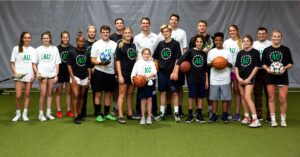Speed and agility become really important when kids hit the U-14 level. Games get faster, players get stronger, and being quick can make the difference between winning and losing the ball. The good news is that you don’t need fancy equipment or complicated workouts to help kids get faster.
The drills in this guide are designed specifically for 13 and 14-year-olds. They’re safe, easy to set up, and focus on the kinds of speed that actually matter in soccer. We’ll cover everything from proper warm-ups to sample weekly plans that coaches and parents can use right away.
Why Speed and Agility Are Crucial at the U-14 Level
At 13 and 14 years old, kids are going through major changes. They’re growing fast, which means their coordination and speed are changing too. This is actually a great time to work on speed because their bodies are learning how to move in new ways.
Soccer games at this age get much more competitive. Players are bigger, stronger, and the pace of play picks up significantly. Speed isn’t just about running in a straight line anymore – it’s about changing direction quickly, reacting to what other players do, and staying balanced while moving at high speeds.
Training speed and agility now helps kids develop good movement habits that will stick with them for years. They learn proper footwork, how to stay balanced when cutting, and how to move efficiently without wasting energy. These skills become automatic with practice, which means players can focus on the soccer part of the game instead of thinking about how to move their feet.
Kids who work on speed and agility also tend to be more confident on the field. When they know they can beat someone to a ball or change direction quickly to avoid a tackle, they’re more willing to take risks and make creative plays.
Warm-Up and Mobility Prep
Warming up is super important, especially for growing athletes. A good warm-up reduces the chance of injury and helps kids perform better during the actual drills. Without proper preparation, muscles are tight and movements look sloppy.
Start every speed and agility session with about 8-10 minutes of warm-up activities:
Light Movement (3-4 minutes) Begin with easy jogging around the area, then add high knees and butt kicks. Keep the pace comfortable – this is just to get blood flowing and muscles warmed up.
Dynamic Stretching (3-4 minutes) Do walking lunges with a twist to open up the hips and core. Add leg swings forward and backward, then side to side. Throw in some arm circles to get the shoulders loose too. These stretches prepare the body for the more intense movements coming next.
Movement Prep (2-3 minutes) Finish with lateral shuffles, skipping, and some light bounding. These movements start to activate the muscles and movement patterns that the speed drills will use.
Keep the warm-up moving but don’t rush it. Kids should feel loose and ready to go hard when the actual training starts. If they’re still feeling tight or stiff after the warm-up, add a few more minutes of light movement.
Speed Drills for U-14 Soccer Players
Pick 2-3 speed drills per session and focus on doing them right rather than doing tons of repetitions. Quality beats quantity every time, especially when kids are still learning proper form.
Sprint Starts
Set up cones 10-15 yards apart. Have players start from different positions – standing, kneeling on one knee, or lying face down. On your signal, they sprint to the far cone as fast as possible.
This drill works on reaction time and that crucial first step acceleration. In soccer, players rarely get to start running from a perfect sprinting stance, so practicing from different positions makes the training more realistic. Give players plenty of rest between reps so they can go full speed each time.
Resisted Sprints (Optional)
If you have resistance bands or can pair up players, try some light resistance sprints. One player provides gentle resistance while the other drives forward for 10-15 yards. The resistance shouldn’t be so heavy that it changes running form.
This drill helps players learn to drive their knees up and use their full stride length. It’s particularly good for kids who tend to take short, choppy steps when they run. Switch partners after each rep so everyone gets to work both roles.
Flying Sprints
Set up a 30-yard area with the first 15 yards as a build-up zone and the last 15 yards as the max effort zone. Players jog through the first section, then hit top speed in the second section.
This drill teaches proper running form at high speeds and helps players learn to relax while sprinting. Many young players tense up when they try to run fast, which actually makes them slower. The gradual build-up helps them find their natural rhythm before hitting maximum speed.
Agility and Change of Direction Drills
Agility drills should look like soccer movements – lots of short bursts and quick changes in direction. Focus on staying low and keeping good body control throughout each drill.
Zig-Zag Sprint
Place 5-6 cones in a zig-zag pattern with about 5 yards between each cone. Players sprint through making sharp cuts at each cone. Focus on planting the outside foot firmly and driving off in the new direction.
This drill mimics the kind of cutting that happens constantly in soccer games. Players learn proper foot placement for cutting and how to maintain speed through direction changes. Watch for players who slow down too much before each cut – they should learn to trust their ability to change direction at speed. Add a ball for additional dribbling practice.
Mirror Drill (Partner)
Pair up players with one acting as the leader and one as the follower. The leader moves around a small area (about 10×10 yards) while the follower tries to mirror every movement. Switch roles every 30 seconds.
This drill develops reaction speed and lateral movement. The leader learns to change direction unpredictably, while the follower works on quick reactions and maintaining good body position. It’s also competitive and fun, which keeps kids engaged.
T-Drill
Set up four cones in a T-shape with 5 yards between each cone. Players start at the bottom of the T, sprint forward to the middle, shuffle left to one cone, shuffle back across to the opposite cone, then shuffle back to center and backpedal to the start.
This drill combines forward sprinting, lateral movement, and backpedaling – all movements that happen constantly in soccer. Time players so they can track improvement, but always prioritize good form over speed.
How to Structure a Weekly Speed & Agility Plan
Keep speed and agility sessions short and focused. Total workout time should be 20-30 minutes after warm-up. At the U-14 level, players are often doing lots of other training, so these sessions need to complement rather than exhaust them.
Do speed and agility work 2-3 times per week, ideally before technical training or team practice when players are fresh. Tired players can’t move at full speed, which defeats the purpose of the training.
Sample Weekly Plan:
Day 1: Sprint starts + cone box drill
Focus on acceleration and basic cutting mechanics. Keep total drill time to about 15-20 minutes.
Day 2: Flying sprints + zig-zag drill
Work on top-end speed and more complex cutting patterns. Allow extra rest between reps.
Day 3 (optional): Resisted sprints + mirror drill
Add some strength component with the resistance work, then finish with reactive agility.
Always prioritize rest and recovery for growing athletes. If players look tired or their form starts breaking down, end the session early. Quality training with proper rest will improve speed much faster than grinding through poor repetitions.
Make sure players get at least one full rest day between speed sessions. Growing bodies need time to adapt to the training stress, and overworking young athletes can actually slow down their development.
Build Speed That Matters
Speed and agility training doesn’t have to be complicated to be effective. For U-14 soccer players, short and focused workouts that emphasize proper form will build the kind of quickness that translates directly to better game performance.
The key is consistency rather than intensity. Regular practice with these simple drills will improve reaction time, cutting ability, and straight-line speed. As players get more comfortable with the movements, they’ll naturally start moving faster and with better control.
Remember that every player develops at their own pace. Some will see improvements in just a few weeks, while others might need months of consistent work. Focus on effort and form rather than comparing players to each other.
Looking for more personalized soccer training? Athletes Untapped helps families find qualified private soccer coaches who specialize in youth development. Whether your player needs help with speed, footwork, or game skills, we’ll help you connect with the right coach. Learn more or explore our soccer training guides.




